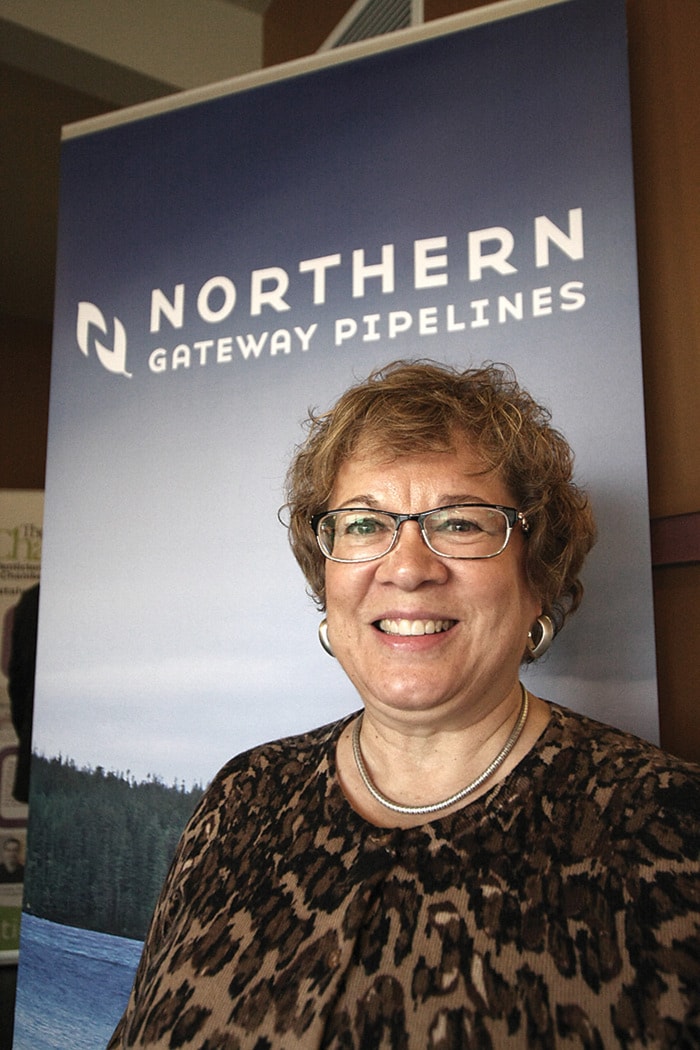It was a noon hour full of promises Monday, as Enbridge vice-president Janet Holder went through the economic benefits and environmental safety standards of the proposed Northern Gateway pipelines for members of the Penticton and Wine Country Chamber of Commerce.
On the economic front, Holder explained construction of the 1,172-kilometre pipeline, proposed to move bitumen from the Alberta oil sands to Kitimat B.C. for transport to offshore markets, will create 3,000 jobs.
When completed, she added, the pipeline will add more than 500 permanent jobs in B.C., and contribute more than $1 billion to the provincial economy over 30 years.
One local company potentially in line to benefit from construction of the pipeline is Britco, a manufacture modular buildings for work camps.
“BC-based Britco has home field advantage and we expect to do well,” said Kareem Allam, director of corporate social responsibility and aboriginal relations.
“Britco is one of the largest private sector employers in Penticton, if not the largest, and we employ more people in Penticton than anywhere else in the world. We hope to win work to continue to grow our footprint in Penticton.”
Holder also said U.S. demand for Canadian oil, which currently absorbs 98 per cent of Canadian oil exports, is diminishing as it continues to find new domestic sources of oil.
According to the Canadian Chamber of Commerce, Canada is losing $50 million a day in revenue because there is no competition for Canadian oil, said Holder.
“Until we can get the oil off the coast to Asian markets, we will continue to sell oil at a discount to the United States,” said Holder.
“That is why this project (Northern Gateway) is so important.”
Britco’s Allam agreed.
“The construction of the pipeline itself would allow for higher prices for Canadian energy ... and more opportunities for our company to win work in the oil sands, work that would benefit our Penticton facility — without a doubt,” said Allam.
Should the National Energy Board’s joint review panel give the go-ahead to the project, and receive approval from the federal government, Holder said Enbridge could begin construction of the pipeline in early 2015.
In addition to a 91.4-cm diameter pipe to transport the bitumen, the project also includes a 30.5-cm diameter pipeline to carry condensate to Edmonton to be used in diluting the bitumen for transport in the pipeline.
The joint review panel is scheduled to release its recommendation to the federal government before the end of the year, and the federal government then has 180 days to decide on the fate of the project.
In addition to any requirements imposed by the joint review panel, Holder said Enbridge is committed to meeting the five conditions established by the B.C. government.
“Those five conditions are really set out to protect the environment, protect the economy and ensure we are working with aboriginal peoples,” said Holder.
“Those five conditions we believe in, we believe they are important for B.C. to set forward, we think it’s important for us to meet them and we think we can meet them.”
Although the project has an economic value to British Columbia and Canada, Holder noted there is also an important environmental component to the project.
“We believe we should never ever sacrifice the environment for economic gain,” Holder said.
“This is not just about economic value.”
Enbridge, Holder explained, has spent years looking at every angle of the project to better understand the potential environmental impacts and how to avoid or mitigate those impacts.
One of the important safety measures to which Enbridge has committed is to man pump stations around the clock, said Holder.
“It means you have another set of eyes on the operation, over and above what would normally be the standard,” said Holder.
Other standards Enbridge has committed to are thicker pipe walls than the current standard, and even thicker at water crossings where the pipe is installed 40 metres below the river beds.
“We will use the latest and the greatest in detection systems and that technology is improving rapidly, she said.
Enbridge also travelled the world looking at the marine aspect of transporting bitumen, including visits to several Scandinavian countries to learn from their best practices to apply them to their facility in Kitimat.
One of those standards Enbridge will adopt is the use of double-hulled tankers.
To ensure proper navigation within Canadian waters, all tankers, will be steered by two Canadian pilots.
“They understand the waters, they understand the weather that happens off the northwest coast of B.C.,” she said.
Tankers will also be accompanied by two berthing tugs as they enter and leave the port in Kitimat. One of the 40-metre tugs, or super tugs, will act as a tug and the other as an escort. The current Canadian standard is for a single tug, said Holder.
Given that the pipeline travels through First Nations territories in several areas, Enbridge, said Holder, has committed to making available a 10 per cent equity interest in the Northern Gateway pipeline to First Nations.
“No strings attached and no money up front,” said Holder, explaining that the funds required to buy into the project would be advanced to First Nations participating in the project.
“In addition, we believe there is another $700 million worth of value to aboriginal communities along the (pipeline) right-of-way,” said Holder.
“We really are trying to build the best pipeline that we’ve ever seen in North America,” said Holder.
